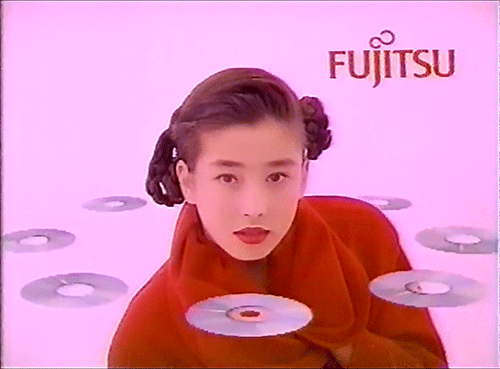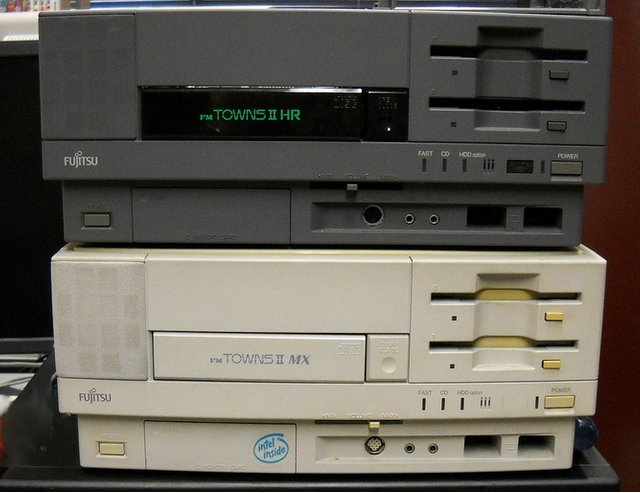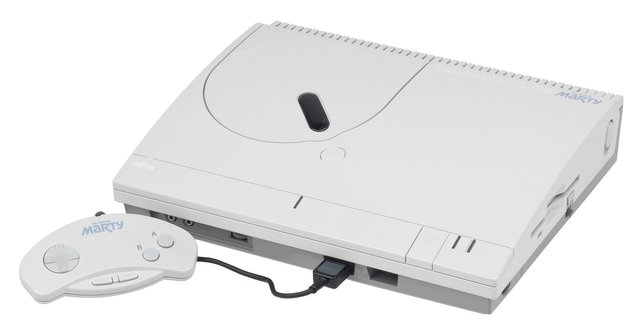
FM Towns
FM Towns was a line of semi-proprietary Japanese computers built by Fujitsu primarily for gaming and multimedia purposes in the late 1980s and early 1990s. I say "semi-proprietary" because at there core was a standard Intel CPU and fairly standard PC hardware. However, there were proprietary components as well and actual PC compatibility was not added until later in the life of the series.
The best comparison to the FM Towns series might be something like the Amiga line. While the core of FM Towns machines was very PC like, it had arcade-like custom video and sound hardware. Resolutions up to 720x512 could be used along with up to 32,768 out of millions of colors depending on the video mode. In addition, up to 1024 sprites could be used. The video hardware featured 512 KB of VRAM and 128 KB of sprite RAM. Sound hardware included a Ricoh RF5c68 which was the same sound chip included in Sega's System 18 and System 32 arcade games, and a Yamaha YM2612 of which a variant was used for some Sega Genesis models. One unique feature at the time was that the FM Towns came with a single speed CD-ROM drive.

The first several models from 1989 to 1991 came in the form of a grey tower and had a 386DX @ 16 MHz and 1 to 2 MB of RAM. The earliest models had a socketed CPU and could be upgraded to a 486DLC if desired. Starting late in 1991, the TOWNS II family was released which was changed in style to be a white (later grey) desktop. These also featured 386DX and 386SX CPUs. The first 486 CPUs came in 1993 and eventually early Pentium CPUs around 1995.

FM Towns II HR and MX
Though the hardware gradually improved over the years, by default newer FM Towns machines were set up to operate in a slower mode to remain compatible with the original software. Unless the software itself switched the machine into a faster mode, there wasn't much practical difference between older and newer machines. Unfortunately, most software, was made to work in the slower mode so that it would remain compatible with older machines. The "Towns OS" was based on DOS and most games were written in protected assembly mode and utilized the Towns OS API for handling graphics, sound and game controllers.
There was also a game system based on the FM Towns hardware called the FM Towns Marty that was released in 1993. It was not very successful and was discontinued after about two years on the market with sales of only about 45,000 units. The various FM Towns computer models sold about 500,000 units in its lifetime.

FM Towns Marty
While more serious software was available to some degree, the emphasis for FM Towns was definitely games. During its life time there were nearly 600 commercial games released for FM Towns. That's roughly equivalent to the number of games released for the Nintendo 64. When originally released the FM Towns was the equivalent of nearly $3000. That's a pretty high dollar amount for what was mostly a games machine. Something like the Amiga, though somewhat less powerful and lacking a CD-ROM, seems like a much better deal at a small fraction of the price.
Read more: https://www.megalextoria.com/wordpress/index.php/2022/04/07/fujitsu-fm-towns-1989/
Thank you, friend!


I'm @steem.history, who is steem witness.
Thank you for witnessvoting for me.
please click it!
(Go to https://steemit.com/~witnesses and type fbslo at the bottom of the page)
The weight is reduced because of the lack of Voting Power. If you vote for me as a witness, you can get my little vote.
Downvoting a post can decrease pending rewards and make it less visible. Common reasons:
Submit
Upvoted! Thank you for supporting witness @jswit.
Downvoting a post can decrease pending rewards and make it less visible. Common reasons:
Submit
Congratulations, your post has been upvoted by @upex with a 1.72% upvote. We invite you to continue producing quality content and join our Discord community here. Keep up the good work! #upex
Downvoting a post can decrease pending rewards and make it less visible. Common reasons:
Submit